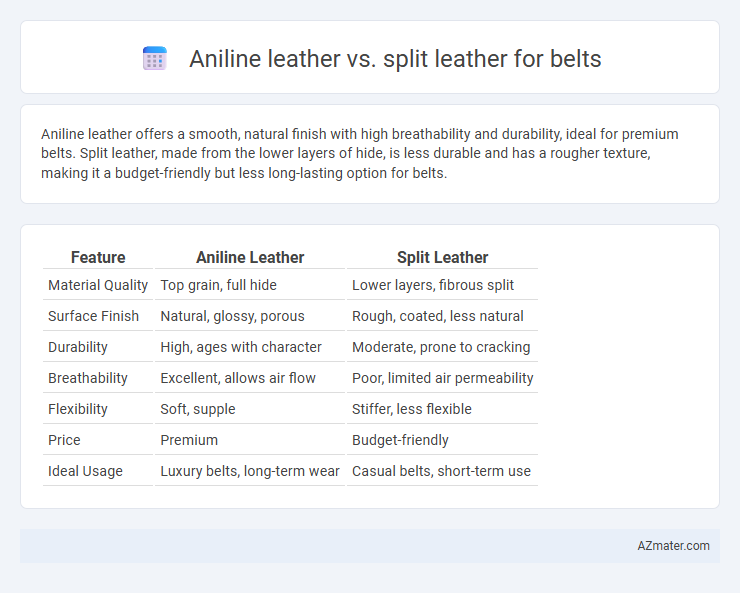Aniline leather offers a smooth, natural finish with high breathability and durability, ideal for premium belts. Split leather, made from the lower layers of hide, is less durable and has a rougher texture, making it a budget-friendly but less long-lasting option for belts.
Table of Comparison
| Feature | Aniline Leather | Split Leather |
|---|---|---|
| Material Quality | Top grain, full hide | Lower layers, fibrous split |
| Surface Finish | Natural, glossy, porous | Rough, coated, less natural |
| Durability | High, ages with character | Moderate, prone to cracking |
| Breathability | Excellent, allows air flow | Poor, limited air permeability |
| Flexibility | Soft, supple | Stiffer, less flexible |
| Price | Premium | Budget-friendly |
| Ideal Usage | Luxury belts, long-term wear | Casual belts, short-term use |
Introduction to Aniline and Split Leather
Aniline leather is a premium type of leather dyed exclusively with soluble dyes, preserving the natural surface and texture while showcasing unique grain patterns and imperfections. Split leather, derived from the fibrous part of the hide left after the top grain is separated, undergoes additional processing to enhance durability but often lacks the natural appearance of aniline leather. Belts made from aniline leather tend to exhibit a softer feel and richer patina, whereas split leather belts prioritize affordability and structural robustness.
What is Aniline Leather?
Aniline leather is a high-quality leather dyed exclusively with soluble dyes, preserving its natural surface and textures without any synthetic coatings. This process maintains the leather's softness, breathability, and unique grain patterns, making it ideal for premium belts that require durability and a luxurious feel. Unlike split leather, which is made from the lower layers of hide and often coated, aniline leather offers superior strength and a more natural appearance for long-lasting, stylish belts.
What is Split Leather?
Split leather is derived from the lower layers of a hide after the top grain has been separated, resulting in a more fibrous and less durable material compared to aniline leather. It often undergoes a process called embossing to mimic the texture of full-grain leather, but it lacks the natural markings and breathability of aniline leather. For belts, split leather tends to be less expensive and less supple, making it suitable for budget-friendly options rather than premium, long-lasting accessories.
Production Process: Aniline vs Split Leather
Aniline leather is crafted from the top layer of the hide and undergoes minimal processing, using soluble dyes that penetrate the hide while preserving its natural texture, markings, and breathability. Split leather, derived from the lower layers of the hide, is heavily processed and often coated with pigments or embossing to imitate the appearance of full-grain leather. The production process of aniline leather results in a more supple, breathable, and premium belt material, whereas split leather belts offer a more affordable option with less durability and natural character.
Appearance and Texture Differences
Aniline leather belts showcase a natural, soft texture with visible grain and slight imperfections that highlight genuine leather characteristics, offering a smooth, luxurious finish. Split leather belts, derived from the fibrous lower layers of the hide, exhibit a rougher texture and are often coated or embossed to mimic full-grain appearance, resulting in a less supple and uniform surface. The distinct difference in appearance and texture makes aniline leather ideal for high-end, authentic aesthetics, while split leather provides a budget-friendly alternative with diminished natural feel.
Durability and Longevity Comparison
Aniline leather offers superior durability due to its full-grain quality and natural oils that resist cracking and wear, making it ideal for long-lasting belts. In contrast, split leather, derived from the lower layers of the hide, tends to be less durable and prone to cracking over time since it lacks the robust grain surface. Choosing aniline leather ensures greater longevity and resilience in belts, maintaining strength and appearance through extended use.
Comfort and Flexibility Factors
Aniline leather offers superior comfort and flexibility for belts due to its natural, untreated surface that allows the material to remain soft and breathable, conforming easily to body movements. Split leather, derived from the lower layers of a hide, typically undergoes more processing and finishing, making it stiffer and less flexible, which can reduce comfort over extended wear. The porous nature of aniline leather enhances moisture absorption and flexibility, while split leather's denser structure limits these properties, causing belts made from it to feel rigid and less comfortable.
Maintenance and Care Requirements
Aniline leather belts require gentle maintenance with a soft cloth and special aniline leather cleaner to preserve their natural surface and prevent fading. Split leather belts demand more frequent conditioning and protection due to their porous nature, which makes them more susceptible to cracking and moisture damage. Proper care extends the lifespan of both types, but aniline leather's delicate finish means it is less durable under heavy wear compared to the thicker, tougher split leather.
Price and Value Considerations
Aniline leather belts command a higher price due to their premium quality, natural finish, and superior breathability, making them a valuable investment for durability and aesthetic appeal. Split leather belts are more affordable, derived from the lower layers of the hide, but often require additional treatments to improve appearance and durability, which can affect their long-term value. Choosing between aniline and split leather depends on balancing upfront cost with desired longevity and natural texture in belt selection.
Which Leather is Best for Belts?
Aniline leather offers a smooth, natural finish with visible grain and breathability, making it a premium choice for high-quality belts prone to aging gracefully. Split leather, derived from the fibrous part of the hide beneath the grain, is less durable and often corrected or coated, resulting in belts that may wear out faster but are typically more affordable. For durability, luxury, and long-term appearance, aniline leather is generally the best option for belts.

Infographic: Aniline leather vs Split leather for Belt
 azmater.com
azmater.com